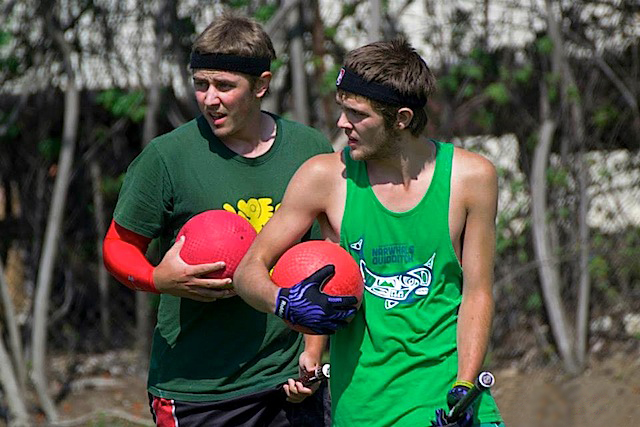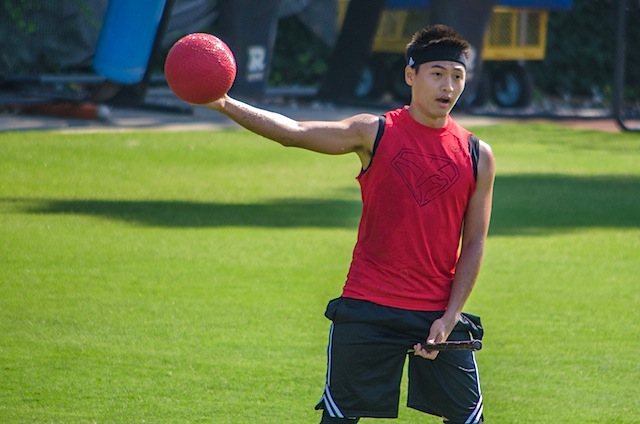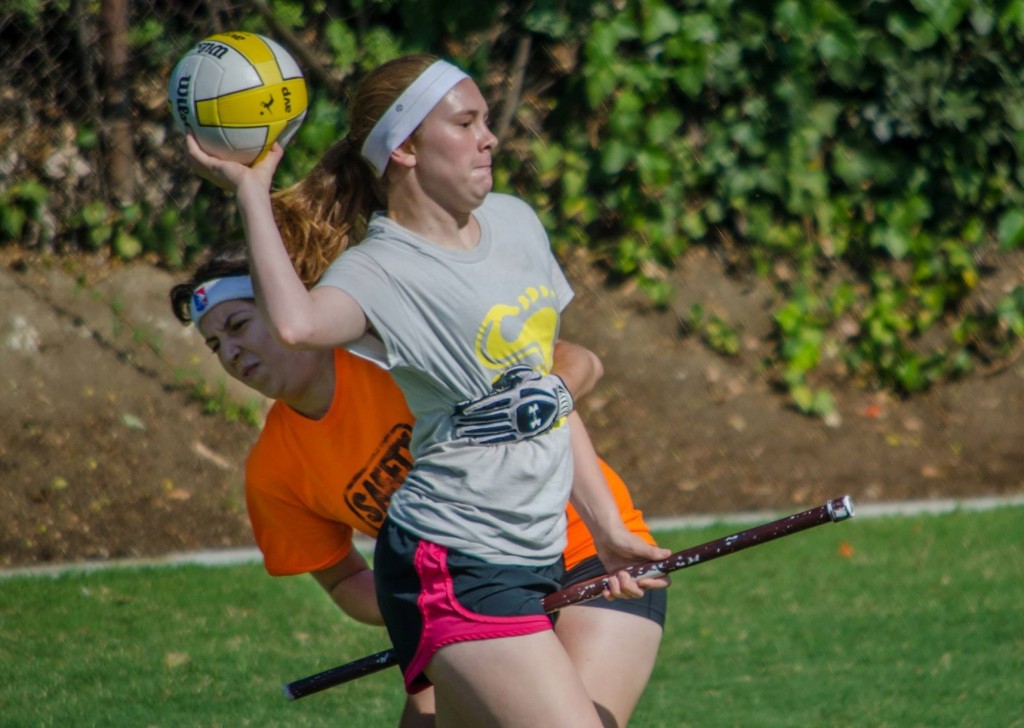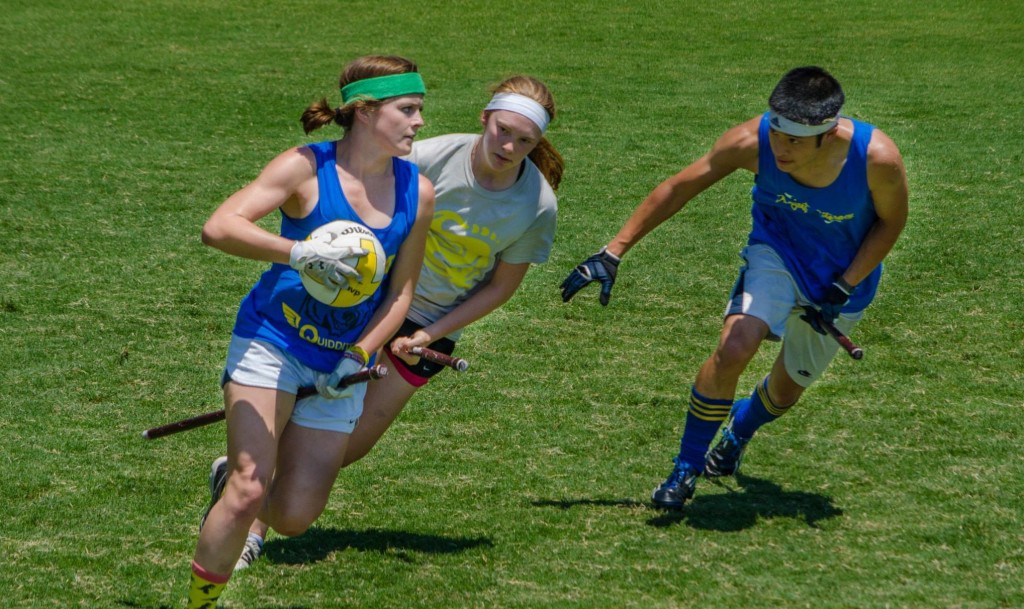- Rule, Britannia, no more?
- Unpopular Opinions: US Quadball Cup 2023
- Proven Contenders: University of Virginia
- Proven Contenders: Rutgers University
- Proven Contenders: University of Michigan
- Proven Contenders: Creighton University
- Different Perspectives: A Look Inside USA Ultimate
- Antwerp QC, Much of Belgian Core, Leaves Competitive Quidditch
Creating a Fantasy – Firemercs Lessons
- Updated: July 19, 2013


Led by All-American Tony Rodriguez, the red team took down the second rendition of Firemercs. Credit: Kat Ignatova/IQA Staff
This weekend, the second annual Firemercs tournament took place in La Cañada Flintridge, CA. Nine teams made up mostly of players from the Western Region took the fields over two warm days. Ultimately, the same colors prevailed for a second straight year as the Red team, led by Tony Rodriguez, defeated Steve DiCarlo’s Blue team by ten points as time expired in overtime. It’s really easy to judge teams in advance, but it’s far more instructive to retroactively look at how teams succeeded and see what about their drafting strategy was successful or unsuccessful.
Lesson 1: Don’t reach to fill a position just because you don’t have one, particularly seeker.
Our first lesson comes from the tournament champions, Tony Rodriguez’s Kryptonyans. While they arguably started out with the largest advantage (by having the best team captain), this advantage was enhanced, though, by coolly and consistently drafting for value. Already knowing he could provide most of a competent quaffle game, Rodriguez used his first pick to take impact beater Peter Lee. With the two best draftable seekers (Keir Rudolph and Porter Marsh) taken in the first round, Rodriguez did not panic and force himself to pick a seeker early. Rather, he waited and continued to amass players that fit into his team while giving great value, nabbing two of the seven best female chasers in the draft in Amanda Nagy and Ericka Phanthip in his first five picks. Had he reached for a seeker with one of these picks, Rodriguez would have had to greatly compromise his starting lineup and lost some of its depth. Instead, he filled out his starting lineup with chaser Michael Binger from UCLA in the third, and took Duston Mazella, another male beater, in the fourth.
In particular, we target seekers for this lesson because more than anything else, the skill set seekers need seems to intersect with what chasers need as well: both positions benefit from quickness, strength, and long reach. As such, unless you have the ability to take a uniquely talented seeker such as Steve DiCarlo, Porter Marsh, or Keir Rudolph, your team will often be better off concentrating on the quaffle and bludger games and entrusting the snitch game to a seeker-by-committee. But this lesson can apply everywhere. If you reach for a player simply because you happen to have a need in a position, you’ll hurt the overall strength of your team.
Lesson 2: Playing a unique strategy can have great results.
Not every position is valued equally. Most teams employ one female chaser and one female beater in their best lineups, but teams can find success utilizing other strategies as well. When preparing for the draft, I fit every single player into a single position and gender, splitting males into one of the two groups for each position, except for seeker and keeper. Of draftable players, there were 10 keepers, 38 male chasers, 23 non-male chasers, 23 male beaters, and 28 non-male beaters. Those ratios look pretty in-line with a more conventional lineup, but if you look a little deeper, we see that certain positions are deeper than others: before my draft, I ranked every single position, and in addition I split all of the players into tiers which were roughly defined as players of similar skill. If I trim the list down just to the top three tiers which is roughly the lowest level I’d want starting for my team, the numbers look slightly less balanced. In the top three tiers, there were 14 male chasers, 13 non-male chasers, 12 male beaters, and 10 non-male beaters. If teams are all playing a conventional one non-male chaser/one non-male beater strategy, the only position that there isn’t enough to get players of starter-level are male chasers, and the several other categories are really close.

Green team’s two male beater sets helped the team go all the way to the semifinals. Credit: Laurel Haspert
Enter two of the four semifinalists: Tony Rodriguez’s Kryptonyans and Tad Walters’s 50 Shades of Green. Both of these teams, rather than forcing themselves into a conventional model, frequently adopted a two-male beater set. In doing so, and by spending early draft picks on some of the few truly elite female chasers in the draft (Vanessa Goh and Amanda Nagy), they were able to provide their teams two of the strongest beater games in the tournament without compromising the chaser lines of their teams much, if at all. The point of this lesson is not to say, “Go away from conventional strategy!” Like with all lessons, they must be applied in context: if every single person is going for two male beaters, then you can maximize your value by going for a one male/one female starting line. Always pay attention to what your opponents are drafting and what depth is left at different positions so that you can maximize the value in each of your picks.
Lesson 3: Consider how your pieces fit together as you draft.
This lesson is more about constructing a chaser line than it is about overall positional balance. The thing to remember is that fantasy quidditch teams aren’t like fantasy football teams: these teams are actually playing games, so you won’t profit simply by taking a bunch of goal scorers. Rather, your chasers (and team in general) need to fit well and be able to play together. You need chasers who can run point, but you also need ones who are comfortable playing off-ball. You need people who can provide physical defense at the point of attack, but you also need those comfortable covering the goals or guarding chasers in open space.
When I was drafting Silver team, I used my first three picks on a seeker and two beaters, which gave me confidence that I’d have very good play coming from those positions. Rather than simply grabbing big names or the top goal scorers, I decided to create a team identity. I wanted us to be the most difficult team at the tournament to score upon, so I focused defensively in my first chaser picks, particularly in on-ball defense. I trusted my beaters to be able to clean up the passing game other teams were developing. I also went after players who would be comfortable playing off-ball in the offense, as I knew that I was significantly more effective if our offense was running through me. Looking at these constraints, rather than go after bigger names in the draft, I went after Northern Arizona’s Luke Sanchez and Silver Phoenix’s Keegan Adlis, and solidified my starting lineup by grabbing Tufts’s Hannah DeBaets with my next pick. All of these players were comfortable playing off ball and looking for passes, and it paid off. This team generated what was arguably the best passing game in the entire draft. Even though the Silver team came in with relatively little fanfare, it ultimately showed it could compete with any team in the tournament, pushing eventual runner up Blue Wasikowski out of snitch range for almost the entirety of the semifinals before eventually being undone in regulation and in overtime by a double DiCarlo.
On the other side of the coin, the Purple Spirit Animals frequently suffered offensively from a lack of options outside of their ball handlers. Almost every chaser on their team was one who was used to dominating possession of the quaffle and was not used to spacing themselves off-ball, which hamstrung their ability to generate any sort of a passing game. In turn, that crippled their offense which only scored nine goals in their four pool play games. Teams, even fantasy teams, have evolved too much defensively to be defeated consistently by one-man offenses, especially when that offense isn’t powered by a Zach Luce or a Tony Rodriguez, who at least would have been able to score a few goals every game by sheer talent. Lacking anyone of that ability, they often found their whole team limited to a couple of goals in a game. By the end of the tournament, Purple’s starting chasers included Porter Marsh, their seeker, and Michael Mohlman, their original starting male beater in order to try to improve the chaser line.
Lesson 4: Good players can play any position competently.
It’s very rare to see strong players be absolutely unable to play any position, and this should allow teams to better achieve positional balance when it’s needed. Perhaps the biggest example of this was UCLA’s chaser Missy Sponagle playing beater frequently in their World Cup run because of injuries, and we saw plenty of examples of this this weekend. Sponagle, for her part, played all four positions for Blue Wasikowski, starting the tournament mainly as a beater before switching to their starting keeper (which will be discussed later, as this change helped key Blue’s turnaround). In addition, we saw Riverside’s Tye Rush see his first major minutes at beater for Blue. Miami’s Matt Ziff won a game for the White team over a strong Green side with two impressive snitch pulls. Vanessa Goh, for her part, may have provided the highlight of the tournament with a diving snitch pull to oust the White team from the tournament. Seeker Keir Rudolph also started every game at keeper for the Silver Snakes, providing me with valuable keeper depth to save my legs throughout the tournament. WIth Phanthip red carded out of the finals and Nagy tiring after playing the majority of the finals, usual beater Kara Levis stepped up for the Kryptonyans and played some chaser in the finals.
Why is this lesson important? Because, much more than normal teams, fantasy teams tend to be undermanned, frequently only having enough players to cover maybe one full line of players and a full line of backups. This means that frequently depth is a huge issue. It makes people who can play multiple positions worth their weight in gold, as it helps you adjust who is playing what positions as needed, rather than having a single injury destroy your entire depth chart. This also provides you with the flexibility to be playing as strong of a lineup as possible. Remembering this gives you the ability to draft the best player available in your later rounds. Rather than saying, “Oh, I need a backup male beater”, you can simply say, “This person is the best player available and will help my team talent level the most.”
Lesson 5: Have a seeker you can trust.
This may seem very much contrary to first lesson, but they differ in what they say. The first lesson simply cautions that you don’t need to draft someone who claims to be a seeker just because you don’t have one. This does not, however, mean that you don’t need a plan at seeker. One of the tournament favorites, The Night’s Watch (Black team), suffered from this the most. They put together an excellent veteran chaser line, but it wasn’t a very strong seeking team. As such, keepers Alex Browne and Zach Luce were frequently put to the task when the game was close, which ultimately helped eliminate them. The Kryptonyans also almost saw themselves lose the tournament, as their best seeker option was frequently Rodriguez. They were ultimately able to use their beater game to stop the Blue team from getting a second and winning grab in overtime, but the game ended up being far closer than perhaps it should have been.
Lesson 6: If you are playing on the team, remember to construct your team accordingly.

Keeper and general manager Tony Rodriguez went for eventual tournament MVP Peter Lee with his first pick, while others chose first picks that overlapped too much with their own talents. Credit: Kat Ignatova/IQA Staff
Fantasy tournaments can vary in how they are set up. In some, the captains are playing on the team they are drafting, while in others they simply draft the team but aren’t allowed to play. For Firemercs, all of the captains were playing on the team, which left some teams at a distinct advantage, since several of the captains would be early first or second round picks in this draft. If simply drafting the captains, Rodriguez, Browne, and DiCarlo would be the first three in some order, with myself coming up right after. Ultimately, Rodriguez’s, DiCarlo’s, and my teams all ended up in the semifinals, with Browne’s black team falling short and taking fifth place. We’ve discussed Black’s seeker problems earlier, but I think their problems actually began with their first pick. With the fourth overall pick in the draft, Browne selected fellow UCLA keeper Zachary Luce, second team All American and arguably the best player in the draft. As his teammate, Browne knew exactly what he was getting in Luce: a ferocious two-way keeper who can effectively cover the hoops both from afar and defend players who manage to get close with the quaffle. On offense, Luce can brutally drive the ball to the hoop or turn to passing options for easy goals. This may actually have been the best value any captain got in the first round, so why do I take issue with it? Well, the largest problem is that I could describe Alex Browne in those terms too. By investing his pick in Luce, Browne ensured that his team would have an elite player playing keeper at all times, which is a great luxury to have, but it’s just that: a luxury. I can’t help but feel that this team would have been more dangerous if they had invested an early pick on an aggressive beater such as Peter Lee or an elite seeker like Porter Marsh.
Lesson 7: Exploit information asymmetry.
This is arguably one of the hardest lessons to apply, but in my opinion, may be one of the most important ones as well. When looking at your draft list, it’s worth considering what players you know best compared to other captains and use that to make draft decisions. As my fourth pick approached, I was sitting with two beaters and a seeker (along with myself at keeper), which means I needed to use the next few picks to round out my chasing lineup. The three people I wanted to pick up (and ultimately did get) were Northern Arizona chaser Luke Sanchez, Silver Phoenixes chaser Keegan Adlis, and Tufts chaser Hannah DeBaets.

Oelze was confident in Hannah DeBaets’ abilities, but waited on her knowing he was the only general manager who had watched her play. Credit: Kat Ignatova/IQA Staff
Unfortunately, because I was positioned early in the draft, I would have two draft picks in rapid succession (with only two Chris Lock picks between them), and then a wait of 14 picks before my next pick. I felt more confident in my ability to replace one of the male chasers than DeBaets, who had been practicing with the Skrewts during the summer. This would suggest I should pick DeBaets with one of those two picks and hope I could catch whatever chaser I didn’t pick in the sixth round. However, when I examined those three players, I considered the following facts: firstly, Adlis came from a highly valued Texas A&M program (in addition to strong genetic lines, being the brother of Jacob Adlis); second, people were unlikely to have a great perspective on DeBaets, and nothing in her bio would set off any sleeper potential flags (first year player, lightly regarded program from a lightly regarded region, very little information about her); thirdly, even among the western teams, the Arizona teams don’t tend to be well known, particularly NAU: the person I’d be most likely to lose Luke to would be his own captain, Cooper Davis. So as long as I didn’t let the pick get back to Davis, I’d be unlikely to lose Sanchez. So, with my fourth pick, scared of Lock taking him, I went after Adlis, even if I actually had Sanchez rated higher. Then, with my fifth pick, I picked up Sanchez to give me my male starting chaser lineup, trusting in anonymity to allow DeBaets to come back to me with my sixth pick. This let me build my starting chaser line with the exact players I desired simply by examining which players I thought I knew better than other teams.
My team was not the only team that exploited information asymmetry: Rodriguez’s Kryptonyans were able to know exactly what they were drafting when they drafted Peter Lee, who was relatively unknown in the west, even after a long career at Vassar. Since Lee, a future teammate of Rodriguez, was practicing with the Lost Boys over the summer, he was able to take guesswork out of the equation and eliminate any risk by taking on an unknown player.
Lesson 8: If depth is limited, value stamina.
As mentioned earlier, most fantasy teams tend to have fewer players than actual competitive teams have, which can lead to forcing players to play significantly more minutes than they’re used to. In a hot environment like Los Angeles, this effect can be even more pronounced, making some picks significantly more valuable. Noted ironmen like Rodriguez and I both played an overwhelming chunk of their team’s minutes, but you saw other players step up as well: the Kryptonyans’s Amanda Nagy played a huge number of minutes, which allowed her team to succeed in running a double female chaser lineup. Purple’s Porter Marsh also was able to come close to living up to the value of his pick, even if his team never found itself in snitch range, because he started playing amazing chaser for his team as well. Similar roles were filled by White’s Becca DuPont and Green’s Vanessa Goh, who justified their high draft status by playing nearly the entire tournament for their teams, giving them an elite level of play at female chaser in that time. Finding players who could chew up lots and lots of minutes ended up allowing a team to look significantly deeper than it might be otherwise.
Lesson 9: An impact chaser affects a game less than a beater. Draft appropriately.
The primary position and gender of the five teams that did not make the semifinals were as follows: male chaser, male chaser, male keeper, male seeker, and female chaser. All of the players chosen were elite, and in my opinion, lived up to their draft potential (with the exception of Alex Makk, whom will discuss in Lesson 14). But the fact remains that it’s significantly harder for a single chaser or keeper to impact the game as much of a beater. If I were to pick a player who had the largest impact this weekend, it would have to be the Kryptonyans’s Peter Lee, whose presence was felt up and down the field. The really elite beaters, such as Lee or Green’s Willis Miles, can affect play all over the field, and unlike a chaser, there’s no way to scheme a defense or offense to simply take a beater out of the game. Similarly, drafting a seeker early means that if you are in a close game, your team is likely to have the advantage (and may be able to save your team some energy, too, by ending games faster). No chaser, no matter how good, can avoid being taken out of a game if the opposing team is willing to devote the energy to doing so or can provide that close game guarantee. This isn’t to say you can’t draft great chasers or keepers in the first round of the draft. Rather, you need to be aware that the overall impact is likely to be smaller if you do.
Lesson 10: If you trust your ability to construct a team, go seeker early. If not, go seeker late.
Seeker is an interesting position. In a close game, it becomes by far the most important position in quidditch with the unique ability to end the game and get you those deciding thirty points. However, in a blowout, a seeker becomes almost useless. Essentially, a seeker is a luxury in that it helps you win close games, but it will do next to nothing if you can’t keep games close. If a seeker can play multiple positions and also give you elite level play at another position (such as Keir Rudolph contributing heavily as keeper for the Silver Snakes), then this doesn’t end up being a problem. But if someone is playing seeker and no other position, you have to trust your ability to construct a team effectively without a first round pick. Personally, I felt extremely confident in my ability to develop a team, even without considering the effect of having Rudolph in my keeper line. On the contrary, Davis, who in Arizona was unfamiliar with many of the California players, probably could not afford a luxury like drafting Porter Marsh in the first round. That team would have been immensely better off by grabbing one of the elite female chasers, elite beaters, or even a player like Jeff Lin (who provided positional flexibility for his team). Purple team massively improved once Marsh started contributing to the chaser line, but that wasn’t enough to overcome their disadvantages.
Lesson 11: Never undervalue pre-existing chemistry.
Fantasy teams are often plagued by players who have never played together. Players who are used to always having the ball suddenly find they don’t play as well without the quaffle in their hands. Players used to their teammates cutting at certain speeds or directions find that they’re unfamiliar with how their new teammates, and so passing games simply don’t develop as well as a team may expect or need.
There’s an easy way to stop this problem, though: draft players who are used to playing together (or are at least familiar with each other). We saw several instances of this in the tournament: Blue team found that most of their offense worked best when the quaffle was passing back and forth between graduated UCLA chasers Jake Tiemann and Jeff Lin, who parlayed their familiarity into one of the best chemistry pairings in the tournament. Similarly, the White team found many opportunities to exploit the existing chemistry between Mollie Lensing and Becca DuPont to ensure their beaters and chasers were on the same pages. Meanwhile, even though they are not from the same programs, Lensing and Austin Quidditch beater Paxton Casey managed to achieve quicker chemistry, at least partially because the two have played with similar teams in similar programs. Perhaps the most successful example in the tournament was the Kryptonyans, who managed to pair captain Tony Rodriguez with starting chaser Amanda Nagy. Nagy and Rodriguez were able to form a menacing duo because of their pre-existing chemistry. The Black team was built on this premise as well. It placed together several players used to playing together at UCLA, pairing Ryan Donahue with Sarah SImko at beater and rolling out a top three including Zachary Luce, captain Alex Browne, and Brandon Scapa.
Lesson 12: If your team is faltering, don’t be afraid to change your strategy.

Switching Missy Sponagle to keeper gave the blue team new life and helped them make a run to the finals. Credit: Kat Ignatova/IQA Staff
Going into the tournament, team Blue Wasikowski was one of the strong favorites, especially after acquiring Jake Tiemann in a controversial trade. But they opened on Day One and seemed to fall flat on their faces, dropping to an 0-2 record against a strong Red side and a shocking Green team. With their backs against the wall, they did what all smart teams do when things go poorly: they changed their strategy. Finding that their offense was not clicking as well as they wanted to when run through Jake Tiemann, they switched up their lineup, moving utility star Missy Sponagle away from beating and switching her to starting keeper. Running the point through Sponagle’s hands, Blue was able to turn their tournament around, pulling off an upset of Browne’s Black team before making their run to the tournament finals. Freed from the pressure usually given to the primary ball handler, Tiemann was able to wreak havoc on opposing defenses, while Sponagle was able to be a distributor to make the offense run beautifully. By avoiding being stubborn and changing their playing style, Blue moved from being a giant disappointment to the surprise of the tournament.
Lesson 13: Buy a lottery ticket.
Several players came into the draft with large question marks, specifically related to health and injury recovery. The two most notable ones were White’s Mollie Lensing and Red’s Kara Levis, but other players, such as San Jose State chaser Julian Rosenberg also could be considered one of these players. Firemerc’s player replacement policy, said that if a player dropped out, you were given the first player off of the wait list no matter what. When Rosenberg dropped out, Silver was initially given Emerson’s Griffin Conlogue, but after he dropped out, he was replaced with a player who had never played before. This policy took some of the risk off of the investment, as if a player had to drop out, your team were guaranteed to get someone to replace him or her. All of these questionable players were drafted much later than their reputations would suggest. Lensing was drafted in the fifth round, Levis in the eighth round, and Rosenberg in the ninth round, with both of the first two likely being first or second round picks if they were healthy. While Lensing did not have full power in her arm, she was able to use her impressive field awareness and phenomenal agility to continue to be a force for White team, just as Levis was able to help add depth to what was already an impressive beating game for the Kryptonyans. While Rosenberg did ultimately drop out of the tournament, because the draft investment was relatively small, it cost his team very little. The ultimate lesson is that, if you fail to see anyone that you see as a sure-fire difference maker when it’s time to make a pick, sometimes the best thing you can do is take a risk and look for someone with major upside instead.
Lesson 14: Sometimes, luck just is not on your team’s side.
This lesson comes to us from Dyllan Fernandez’s Orange Team: Roughly five minutes into their first game, third overall pick Alex Makk took an elbow to his forehead which opened up a cut that required stitches to close out, knocking Alex out from anything but off-pitch seeking for the rest of the tournament. While they were able to replace him with USC’s Ryan Parsons, who likely would have been drafted in the first three rounds, the loss of their star player showed, as the Orange team was really never able to pull it back together.
Similarly, snitch pulls can come up as a result of bad luck, good luck, poor snitching, or lucky pulls. Even the best seekers are susceptible to a mistake. Bad luck happens, whether it’s through injuries, dropouts, or lucky snitch snatches. When they happen, it’s best to simply recognize bad luck for what it is and not unduly stress over it.

9 Comments